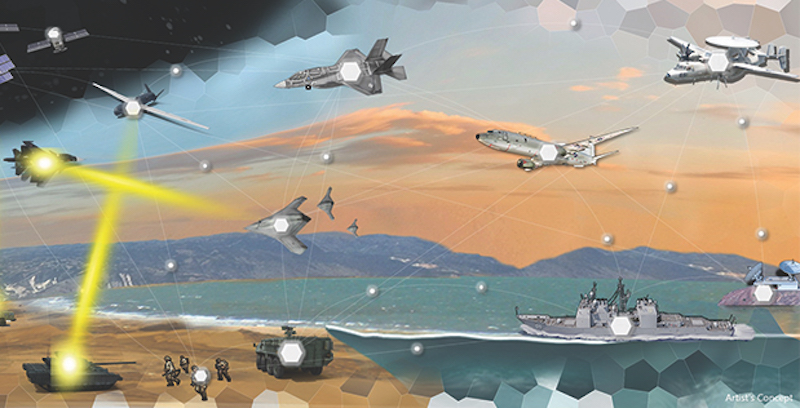作为工业4.0研究院的重要标杆对象,DARPA和兰德智库一直是跟踪研究的目标。DARPA作为数字孪生体和马赛克作战(Mosaic Warfare)提出者,力图开拓第四次工业革命的通用目的技术(GPT,General-Purpose Technologies)。
DARPA在提出马赛克作战之前,在复杂工程系统概念体系上已有较大的进展,不仅在美国国防部数字工程上助力颇多,而且在作战概念发展上有巨大的突破。
从颠覆性技术的价值来看,把它应用到作战领域更能获得回报。数字孪生战场实验室发现,DARPA最近几年把精力集中到马赛克作战研究上,甚至把战略技术办公室(STO,Strategic Technology Office)的任务全面转到马赛克作战上面,这是绝无仅有的。
在DARPA官方介绍中,马赛克作战是“快速、可扩展、自适应的联合多域杀伤力。”

在构建马赛克作战复杂工程体系的时候,分为了马赛克技术(Mosaic Technologies)、马赛克网络服务 (Mosaic Web Services)以及基础战略技术和系统(Foundational Strategic Technologies and Systems)。
首先来看看马赛克技术。DARPA介绍称,马赛克技术是一种体系级概念,它能够适应任务需要的速度。其目标是“作战人员抵达战场,可以利用任何可用的能力组成所需的效果。”
马赛克技术能够提供规划与组成、互操作性、执行三方面的功能,这些功能必须建立数据自动化,因为速度是马赛克作战的核心。
在具体推动马赛克技术的研究中,DARPA使用了作战分析、兵棋推演、军事演习、需求分析等方法,从而充分论证验证作战计划。这一点正是数字孪生体能够发挥价值的地方,也是数字孪生战场建设的主要目标。
其次,DARPA提出了马赛克网络服务,这实际是它企图重现“互联网”革命性发展的一个宏大计划。
马赛克网络服务包含传感器、搜寻器和电子战。简单讲,这就是未来的“互联网战场”,工业4.0研究院称之为“数字孪生战场”。
DARPA表示,自提出马赛克作战之后,它就一直在研发这些系统,以满足美国国防部JADC2的需要。目前的难点主要体现为对抗环境下的应用,这一点类似互联网连接环境不佳的时候,如何保证信息有效安全传达。
工业4.0研究院认为,要实现这样的目标,需要在“数字孪生网络”基础理论上有所突破,这有点类似20世纪70年代兰德智库提出“分布式通信”的开创,否则不太可能有后来的“互联网原型”。
当然DARPA非常清楚这个挑战,所以在最后一个关键要素中,它提出了基础战略技术和系统。
对于基础战略技术和系统,DARPA只言片语,所言不详。“字少事大”,这是应了这句话,马赛克作战的根本蕴含在基础理论的突破,例如,复杂工程系统、数字孪生体科学等。
从工业革命发展的各个阶段来看,英国、德国、日本等国都跟美国开展了激烈的竞争,然而这些国家最终都败给了美国。这些失败国既缺少基础研究引领技术革命的深刻认识,又无法投入充足的资金和人力开展基础研究,最终落得泯然众人的结局。
针对正在发生的第四次工业革命,中国的基础研究显然不足,这一点跟日本40年前非常类似。经济发展和增长的惯性掩盖了新动能缺失的挑战,人们既不尊重无名之辈的创新,也未建立适应新时期的包容机制。
希望我国可以跨越这个难关。
作者:王明芬,工业4.0研究院副院长
英文原文:
DARPA’s Strategic Technology Office (STO) aims to provide the U.S. military lethality using a strategy called Mosaic Warfare: fast, scalable, adaptive joint multi-domain lethality. STO’s areas of interest include: Mosaic Technologies, Mosaic Effect Web Services (EWS), Mosaic Experimentation, and Foundational Strategic Technologies and Systems..
Mosaic Technologies
Expanding on technology development to fight as a system of systems (SoS), STO accelerated the concept to adapt at mission speed. The ultimate vision: warfighters arriving at the battlespace and immediately composing a desired effect from whatever capabilities are available. In achieving “Mosaic Warfare,” Mosaic Technologies will need to provide solutions or automate the following functions:
Planning and Composition: A commander leading a Mosaic Warfare-based force requires automated decision aids and tools for determining what the basic force should look like. Technologies will empower a theater commander to perform at campaign planning time what today occurs through years of operations analysis, war gaming, exercises, requirements analysis, and doctrine development.
Interoperability: With a Mosaic Warfare force package developed, machine-to-machine interoperable technologies are needed to implement a new warfighting architecture of global interoperability at mission speed.
Execution: Technology that combines battle management decision support and machine autonomy is required. Technology will need to address issues such as resource management for re-allocating capabilities at combat speed, task planning for specific system assignments, and training for warfighters operating new mosaic elements without prior experience.
Mosaic Web Services
STO has a legacy of developing advanced mission systems technologies: sensors, seekers, and electronic warfare. Recently, STO has been developing these systems to enable and be enabled by an SoS. In Mosaic Warfare, these capabilities are ‘tiles’ within the mosaic, or Mosaic EWS. STO is seeking technologies that focus on novel sensors and effectors consistent with the Mosaic Warfare strategy, such as the “find and fix” portions of the kill chain and offensive non-kinetic effects for employment against peer adversaries.
Sensing: STO continues to seek new, innovative methods for finding difficult targets in contested environments that provide capabilities for performing the initial finding and cueing of potential, likely targets to fill current system gaps. Finding and prosecuting target with effects chains requires the ability to detect, track, and maintain custody of targets across widely disparate sensors residing in various domains. STO is interested in processing technologies that can ensure chain of custody between these sensors to ensure confidence and accuracy as targets are passed across cross-domain effects chains.
Non-Kinetic Effects: STO seeks methods to provide warfighters a range of scalable options to win against a peer adversary in a major conflict situation by providing a complex diversity of dilemmas. The focus is on using non-kinetic effects against an adversary to degrade or defeat capabilities and advances, or create confusion and uncertainty for deterrence and de-escalation. Modeling tools for tailoring precision non-kinetic effects, even when target knowledge is highly uncertain, is pursued.
Foundational Strategic Technologies and Systems
STO is pursuing innovative ideas for systems and Mosaic Warfare architectures incorporating disruptive technologies that provide significant potential capability improvement across multiple focus areas. Technologies would reduce the size, weight, power, or cost of systems; allow for adaptability and/or rapid refresh; and offer significant advances in system-level performance.

评论